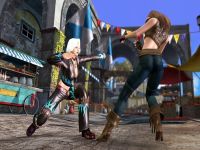
Review: Dead or Alive 4 188
- Title: Dead or Alive 4
- Developer: Team Ninja
- Publisher: Tecmo
- System: Xbox 360
- Reviewer: Zonk (whoisdialogue)
- Score: 7/10
Despite the cachet of being part of the 360's 'launch window', Dead or Alive 4 doesn't quite live up to the pedigree of its Dreamcast cousin. It does come closer than any game since DOA2, though, with liquid-fast gameplay, stunning visuals, and a great online component.
There's only so much you can do to shake up the formula in a fighting game, but Dead or Alive has always managed to entertain on the gameplay front. People hit each other in the most interesting ways, with reversals, throws, unique fighting styles, and plenty of combos. The nearly two dozen fighters each have their own way of inflicting pain, and with so many options to choose from it's likely you'll find at least one character that fits with your preferred play style. Combat is lighting-fast and extremely smooth, with both PC and NPC fighters slipping into a groove within seconds of the match beginning. DOA 4 plays like real-life fights often pan out: quickly and painfully. Many matches don't last more than 20 seconds or so, ensuring you'll get plenty of gameplay for your time invested.
In fighting games, interesting modes are all-important to ensure continued interest. Regrettably, DOA doesn't show much imagination there. The 'Story' mode pits you against eight opponents, the order of which is set in advance for each character. Most of them are simple one knock-out fights, but some of them attempt to tell a (very confusing) tale by offering up short cutscenes afterwards. The final match-up is with a green-glowing character that just doesn't fight fair. While most of the matches are moderately challenging, the difficulty level with the final boss leaps off the scale. This can be a rude awakening for a player who's happily button-mashed his way through the other opponents. Even on the normal level of difficulty the disconnect between the last character and the one before it can be unnerving, and for some reason there is no easy level. You can continue an unlimited number of times, thankfully, which will be required to defeat boss lady. You are rewarded for your efforts with a meaningless but extremely pretty cut-scene when you do finally defeat her. Fighting game story modes are always fairly thin, but the tissue paper consistency of this title's story was frustrating in light of more sophisticated titles.
The other modes are standard fair. There's a 'vs. mode' for playing human opponents or trying one-off matches with the computer. 'Team Battle' allows for competitions, and the possibility of having tag-team battles. Only one fighter can compete at a time, but tagging allows for a second shot if your first fighter is taken out. 'Survival' pits you against a never-ending lineup of opponents, and is one of the primary sources of unlockables. Because of the speed of matches and the promptness of a new opponent appearing, Survival is probably one of the most replayable modes. 'Time Attack' challenges you to defeat six opponents, each twice in a row. You're racing against the clock, and the tough final opponent from the Story mode ensures this is an extremely challenging way to play. There's also a 'Sparring' mode that teaches you moves and techniques, but fails to inform on some of the more tactical aspects of the game. While Survival mode is entertaining, with a brisk pace that will satisfy a player looking to get out some tension, I was left wanting more. Soul Calibur III is the obvious comparison here, and despite the failure of the 'Chronicles of the Sword' mode Namco at least made the attempt to expand the genre.Online play is the final mode the game offers, and for some will be where they live and breath for the next few months. Ninja has changed things up a bit by offering more than just a cookie-cutter game lobby. Joining a game actually places you into a small waiting room, which can be decorated in different styles. A little avatar of you (by default a ninja) wanders around the area. It's really just a hang-out before you enter the game, and I'm not really sure what the purpose of the waiting rooms are. Once you're in the game, there are several tweakable settings, allowing for tag-team matches as well as straight-up fights. By default the game type is 'winner stays', giving the game a neighborhood arcade feel of sociality to it. Winning matches increases your grade and earns you 'Zack points'. The grade is a measure of how you stack up to other players (From A to F), and the points can be spent on tweaking your little avatar. As your grade increases you'll be matched with ever-harder opponents, ensuring everyone has a fair fight.
While it is immensely fun to play against other people, even the ones who talk too much, there are issues. My net connection is fairly stable, but I experienced varying levels of lag in almost every match. At its smoothest you can hardly tell the difference between an online and offline match. At its worst characters pause in the air, and it can be hard to understand the flow of the fight. Reassuringly, even in laggy matches my actions seemed to be translating into combat reasonably quickly. Half the fun of a DOA fight is the speed, unfortunately, and that lag hurts the feel of the game. I've seen differing levels of complaint with this issue. As always, your mileage may vary. I also would have liked the 'Zack points' to have more meaning within the game. You can buy new costumes for the fighters, and purchase new avatar bodies, but I would have preferred to customize the fighters themselves rather than my dinky little waiting room avatar.
Eye candy is the most apt label you could put on this game. DOA's fighting rings go beyond good looks, and are probably some of the most interactive arenas seen in a fighting game to date. There are many to choose from, happily. Some examples include a downtown, night-time city streets brawl, a plateau on the serengeti, and a plot of dinosaur-infested jungle. What makes the venues special is the level of depth they exhibit. The street fight, for example, features neon glare off of the sidewalks, cheering onlookers, and the occasional speeding car. Other arenas feature multiple levels, such as the gorgeous river-crossing rope bridge arena. You can fight on the bridge, or toss your opponent over the edge and into the water. Parts of the arenas can be destroyed, as well. Getting your opponent to a lower floor in the plush ballroom arena can either be done via a set of painful looking stairs, or an even more painful looking toss through a plate-glass window. The arenas are well done, attractive, and definitely one of the highlights of the game.The rest of the game looks good, but the moment-to-moment gaming only looks about as good as a high-end Xbox title. This may be because of the squeaky-clean anime style of the characters, but it just didn't look all *that* much better than DOA Ultimate for the original Microsoft console. Despite that, the sheer power of the 360 ensures extremely high framerates, and supports the speed of the title's combat. Additionally, there are occasional moments when it's obvious this is a next-gen console. My fighter of choice is Jann Lee, and there's a nice 'bulging veins' effect when he poses for the camera after a win. Similarly, the clothing and hair simulation is quite impressive on some of the female characters. Where the console really shows off is in the cut-scene rewards for defeating story mode. It's easy to talk about the beauty of cut-scenes, given their pre-rendered nature, but they're still some of the most impressive imagery I've yet seen on the 360. It's disappointing that the 'next-gen flavour' couldn't be maintained throughout the game.
Dead or Alive 4, then, continues the series tradition of offering typical fighting action with good looking and varied characters. Despite the game's late arrival, fighting game fans have no doubt already purchased and poured their heart into what this title has to offer. For more casual players, DOA 4 offers entirely typical gameplay. Button-mashing won't get you as far as it will in the Soul Calibur series, and the level of replayability for the average gamer may be somewhat low. If you're looking for a simple, good-looking fighter Dead or Alive 4 will serve your needs well. Those looking for brains with their beauty may want to look elsewhere.



Re:A Brief And Entirely Inappropriate Summary (Score:5, Insightful)
HD vs non-HD (Score:1, Insightful)
What XBOX does Zonk have? (Score:3, Insightful)
I hope you were playing this game on a WideScreen HDTV. I have the old DOA3 and have played both on my Sony SXRD and the differences are jaw-dropping. The cut scene and level detail are simply breathtaking.
Stop reviewing 360 games without the proper hardware. Its like reviewing Half Life 2 with a 13" monitor and playing with a gamepad.
DOA gets no respect (Score:2, Insightful)
Soul Calibur (Score:3, Insightful)
Re:DOA gets no respect (Score:3, Insightful)
Typically I enjoy most fighting games, but often do not have someone to play the game with. Recently I've met a friend who is very into fighing games, so we've had a few nights going back and forth with them.
The problem here is that the skill level difference is so much that you just can not learn to play against them in vs mode. It started with SC and me getting my ass handed to me until I spent a good day or two with the move list practicing. From that point with one character I could somewhat hold my own.
What I liked about doaU was that I was able to learn to play better while playing the person. DOA on the lower level (I don't play tourny level players so I can't speak for that) is about beating the other person.
I can just guess what most moves coming out will be, but the more I play, I just have to learn what level the attacks my opponent's are going to be so that I can reverse them. I spend more time just watching and countering/guarding, then throwing/poking with moves I don't know , and I do pretty well. Sure, I could learn juggles and all that to improve my game, but I don't need that, and that is why I love doa.
Visual treat, no dobut. But simple to pick up, with enough depth in there that I don't have to spend a few days in practice mode learning 4000 movies for just one character.
So doa is the casual man's fighting game, and it does a damn fine job of it.